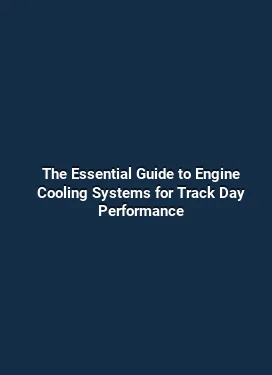Anti-Lag System Installation Guide for Track Cars Complete Setup
Installing an anti-lag system (ALS) is a specialized process aimed at minimizing turbo lag and maximizing throttle response on high-performance track cars. This guide walks through the complete setup, from understanding the principles behind anti-lag to practical installation steps, tuning strategies, and long-term durability considerations. Readers will gain actionable insights on component selection, installation order, sensor integration, and post-install checks that ensure consistent performance under demanding track conditions.
Foundations of Anti-Lag: Why it Matters in Track Environments

Anti-lag work by maintaining turbine wheel velocity during throttle transitions, reducing the delay between driver input and turbo response. In track settings, where rapid throttle modulation is essential for maximizing corner exit speed and maintaining a stable power band, ALS can offer a meaningful performance edge. The system typically manipulates ignition timing, air-fuel ratio, and exhaust gas recirculation during closed-loop boosts to sustain spool and minimize pressure drops across the turbine. A well-tuned ALS preserves throttle response without inducing excessive heat buildup or compromising engine reliability.
Key considerations include turbine housing selection, boost target ranges, and the compatibility of ALS with the engine control unit (ECU). While some teams rely on bespoke, race-spec ALS configurations, others adopt commercial systems with proven map libraries. Regardless of approach, a successful ALS setup delivers fast throttle response, consistent boost delivery, and a manageable feedback loop for the driver and data collection system.
Choosing the Right Anti-Lag System for Track Use
Selection hinges on engine architecture, turbocharger size, and the level of abuse the car will endure on the track. A robust ALS should integrate with the existing fuel management and ignition systems without destabilizing idle or compromising reliability at high temperatures. Considerations include compatibility with electronic fuel injection (EFI) or carbureted systems, the presence of a fast-acting throttle plate, and the ability to operate across multiple RPM bands without excessive fuel consumption.
When evaluating options, review the following attributes: latency and response time, heat management strategy, ease of integration with current sensors (MAP, MAF, wheel speed, exhaust pressure), and software flexibility for map customization. Some systems emphasize aggressive spool during upshifts, while others are tuned for sustained boost through complex track segments. A common best practice is to align the ALS with a programmable ECU that can handle real-time adjustments and logging for ongoing refinements.
Core Components and How They Interact
An effective ALS setup relies on a tightly knit set of components and control logic. The central elements typically include a controller unit, ignition timing adjustment mechanism, exhaust bypass or valve control, boost sensing, and a robust wiring harness designed for high-heat environments. The controller interprets sensor data and outputs commands to ignition modules, fuel injectors, and exhaust valves to generate a controlled lag mitigation cycle. This cycle keeps exhaust gases flowing toward the turbine, maintaining wheel speed and reducing lag during rapid gear changes.
Boost management remains critical. Over-boost or aggressive timing during ALS can induce knock or fuel-rich environments, especially on track surfaces with varying temperatures. Consequently, most setups implement conservative safety margins and fail-safes that revert to a stable baseline if sensor readings swing outside expected ranges. The interplay between ignition retardation, fuel trimming, and exhaust gas pressure is the lever that delivers consistent spool and predictable power delivery.
Sensor Suite and Data Integrity

Reliable ALS operation demands precise sensor data. MAP sensors track manifold pressure, providing a core input for boost strategies. MAF or AFM sensors help monitor airflow and maintain correct air-fuel ratios during ALS operation. Crank and cam position sensors ensure timing advances stay synchronized with piston position, preventing misfires. Additionally, exhaust pressure sensors can reveal backpressure changes that affect turbine dynamics. A clean, shielded wiring harness minimizes electrical noise, which is crucial for stable ALS behavior on a race track where EMI and vibration are prevalent.
Exhaust, Manifold, and Turbine Considerations
ALS interacts directly with the exhaust manifold and turbine housing. A properly tuned ALS benefits from a manifold designed to sustain heat and resist distortion under rapid boost cycles. The turbine’s thermal mass influences how quickly spool recovery occurs after the ALS cycle ends. In track settings, selecting a turbine wheel with the right trim and a small, efficient wastegate helps maintain consistent boost without excessive flutter or compressor surge. A well-matched exhaust system reduces backpressure peaks and supports stable turbine velocity during half-lap sessions.
Installation Workflow: A Step-by-Step Practical Guide
Approaching installation methodically minimizes risk and reduces the need for rework. The following workflow outlines a practical path from preparation to initial testing, followed by iterative tuning sessions. Each step emphasizes data-driven decisions and safe operational limits to protect the engine and turbo system.
Step 1: Pre-Installation Assessment
Begin with a thorough inspection of the current turbo system, ignition map, and fuel delivery hardware. Confirm that the engine internals, cooling system, and oiling are prepared for higher thermal loads typical of ALS. Document baseline boost curves, ignition timing, and air-fuel ratios under light, medium, and full-load conditions. Identify preferred operating windows for ALS activation, typically at mid to high RPM ranges where lag is most noticeable in track scenarios.
Step 2: Component Mounting and Routing
Mount the ALS controller in a location with secure mounting, adequate cooling, and minimal exposure to heat soak. Route sensors and wiring away from hot manifolds and moving parts. Use high-temperature loom and shielded cables for critical signals (MAP, crank, and cam sensors). Ensure a clean ground reference and isolate high-current lines to prevent voltage drop from influencing sensor accuracy.
Step 3: Hydraulic or Electronic Valve Integration
Configure the exhaust bypass or impedance valve, ensuring it can rapidly respond to control signals without stalling. For electronic valves, verify response time and torque capacity of the actuator. If a hydraulic option is used, confirm reservoir pressure is stable and hoses are rated for sustained boost conditions. The goal is a predictable, repeatable valve response that aligns with the ALS timing strategy.
Step 4: Sensor Calibration and Baseline Tuning
Calibrate sensors to factory or OEM references, then establish a baseline spray of fuel and timing under steady-state conditions. Next, implement a conservative ALS map that activates at moderate throttle with moderate boost, progressively increasing aggression as confidence grows. It is common to begin with a soft ALS activation threshold and an initial retardation amount that minimizes knock while preserving spool.
Step 5: Safety Interlocks and Redundancy
Install safety interlocks to revert ALS behavior if critical parameters deviate. This can include over-boost protection, fuel pressure drop, or engine temperature extremes. Redundant sensors or watchdog timers help prevent runaway conditions. Document fail-safe behavior in the event of sensor loss or ECU communication failure, ensuring the driver retains a safe baseline power curve.
Step 6: Initial Road and Track Testing
Begin with brief, controlled sessions to observe system response under real-world loads. Use data logging to visualize ignition timing shifts, boost response, and AFR stability during ALS activation. Pay attention to any abnormal wheel spin, misfires, or unexpected heat buildup. Incrementally advance the ALS map only after confirming stable behavior in each test segment.
Tuning Best Practices: From Data to Driveability
Fine-tuning is a continuous loop of data collection, analysis, and incremental map adjustments. The objective is to achieve a crisp, predictable throttle response without sacrificing engine reliability or fuel efficiency beyond acceptable track-day norms. Below are practical tuning guidelines that help convert data into meaningful performance gains.
First, align ALS timing with the engine’s thermal envelope. In high-boost environments, it is prudent to limit ignition retard during ALS to prevent knock. Second, monitor AFR when ALS is active; a strategic lean or stoichiometric shift during spool can be beneficial, but any lean excursion should be avoided in high-load conditions. Third, adjust the valve actuation timing so that the exhaust bypass opens and closes with minimal lag relative to the driver’s throttle input, preserving a consistent turbine speed.
Trend words to track include turbocharger lag reduction, boost stability, exhaust gas temperature (EGT), and drive-by-wire response. LSI-oriented terms that naturally fit into this context are turbo efficiency, turbine housing, compressor surge, heat soak, fuel trim, knock mitigation, data logging, and reliability under race conditions. By focusing on these linked concepts, tuning becomes a matter of balancing aggressive performance with durable operation.
Heat Management and Durability Under Track Conditions
ALS increases thermal load due to sustained boost and frequent throttle perturbations. Effective heat management involves upgrading intercooling capacity, optimizing radiator flow, and ensuring adequate oil cooling during long sessions. Materials selection for exhaust components and heat shields further mitigate thermal stress. Durability hinges on consistent lubrication, stable oil pressure, and adherence to service intervals that account for the elevated exhaust temperatures associated with ALS use.
Regular inspection of exhaust gaskets, tightenings, and vibration mounts is essential, as track environments expose components to higher mechanical stress. A well-executed ALS setup respects the engine’s limits and preserves long-term reliability by avoiding aggressive operation beyond the validated tuning range.
Monitoring, Data Logging, and Continual Improvement
A robust ALS implementation relies on comprehensive data logging. Track teams commonly log boost pressure, ignition timing, AFR, EGT, oil temperature, crank and cam signals, and valve position. Analyzing this data across sessions reveals trends, guides incremental map refinements, and helps identify early signs of component wear or imminent failure. Visualization tools enable quick interpretation of response curves, while a well-organized data workflow accelerates iteration cycles and reduces the risk of introducing instability into the system.
In practice, establish a baseline log for the car’s natural behavior without ALS, then compare it against ALS-enabled runs. Look for a reduction in lag lag time, a consistent spool rate through higher RPMs, and minimal changes to the fuel system during ALS operation. If data indicates uneven response or overheating, revisit sensor calibration, heat shielding, and cooling capacity to restore balance.
Real-World Scenarios: From Street to Super-Track
ALS installations vary widely based on vehicle usage. For endurance racers, reliability and smoothness during long stints are paramount, so the ALS strategy emphasizes stability and conservative boost control. For sprint races, the emphasis shifts toward maximum throttle response and aggressive spool, with tighter tolerances for heat and fuel management. In time-trial or hill-climb contexts, optimization focuses on maximizing power delivery across a wide RPM band while maintaining predictable shut-off characteristics that avoid engine stress during rapid deceleration.
Across all scenarios, the best outcomes come from disciplined testing, progressive calibration, and consistent data-backed adjustments. A professional-grade installation balances driver confidence with mechanical integrity, ensuring the ALS contributes to lap-time improvements without compromising safety or reliability.
Maintenance and Long-Term Care
Maintenance should be integrated into the race program. Key checks include verifying valve seals and actuators, ensuring sensor connectors are clean and secure, inspecting wiring harnesses for loom wear, and confirming the integrity of the intercooler and charge-air piping. Regular fuel system inspections and periodic ECU software updates further support stability. A structured maintenance plan reduces the likelihood of unexpected failures during critical track sessions and helps preserve the ALS’s performance gains over time.
Conclusion: Embracing a High-Performance, Predictable ALS Experience
Successful ALS deployment is a synthesis of precise hardware selection, thoughtful installation, rigorous tuning, and disciplined data-driven refinement. Track cars that implement an ALS thoughtfully can achieve faster lap times through sharper throttle response and improved brake-to-accelerator transitions, all while maintaining engine integrity and system reliability. The journey from concept to reliable on-track performance is iterative, requiring careful attention to sensor fidelity, heat management, and systematic testing to translate raw data into tangible competitive advantages.






